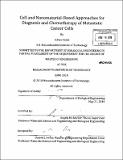Cell and nanomaterial-based approaches for diagnosis and chemotherapy of metastatic cancer cells
Author(s)
Kohli, Aditya (Aditya Gobind)
DownloadFull printable version (9.966Mb)
Other Contributors
Massachusetts Institute of Technology. Dept. of Biological Engineering.
Advisor
Angela M. Belcher.
Terms of use
Metadata
Show full item recordAbstract
Metastasis is a multistep process during which tumor cells separate from a primary tumor, penetrate the bloodstream, evade host defenses, and colonize distant organs. This final and fatal step in tumor development is the cause of more than 90% of cancer related deaths. Therapies and diagnostics can be targeted to metastasis at three points in its progression: the primary tumor, the secondary tumor, and circulating tumor cells (CTCs). While much work has focused on primary tumors, less effort has concentrated on targeted isolation, detection and therapy of deeply penetrated metastases and CTCs. Here, I discuss cell and nanomaterial-based approaches for detecting and ablating these malignant populations. The number of CTCs in the blood directly correlates with disease progression; however, the lack of definitive markers has limited their isolation and characterization. I have demonstrated the potential use of platelets as a cell-based marker for isolation and detection of CTCs. Using phage display technology, it was possible to identify candidate peptides specific to mesenchymal-like tumor cells that may mimic the motile and aggressive CTC population. In order to detect and ablate metastases and CTCs, M13 bacteriophage was engineered into a platform for simultaneous tumor targeting, imaging, and therapy. Single-walled carbon nanotubes (SWNTs) and doxorubicin, a chemotherapeutic agent, were loaded on phage for fluorescent near-infrared imaging and cytotoxicity of metastatic lesions, respectively. The near-infrared optical properties of SWNTs in the "second window" make them promising candidates for imaging nascent and deeply seeded tumors. This approach provides an 'all-in-one' platform for targeted fluorescence imaging and efficient drug delivery and may allow for real-time monitoring of tumor response to drug regimens.
Description
Thesis (M. Eng.)--Massachusetts Institute of Technology, Biological Engineering Division, 2010. Cataloged from PDF version of thesis. Includes bibliographical references (p. 58-63).
Date issued
2010Department
Massachusetts Institute of Technology. Department of Biological EngineeringPublisher
Massachusetts Institute of Technology
Keywords
Biological Engineering.